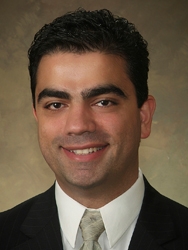Procedure presents new option for patients with complex anatomy
For patients who need a new aortic valve but who are poor candidates for either surgery or transcatheter aortic-valve replacement (TAVR) through femoral-artery access, the Cooper Heart Institute now offers a new approach called transcaval TAVR.

Georges I. Kaddissi, MD, FACC
In March, Cooper interventional cardiologist Georges Kaddissi, MD, FACC, FSCAI, member of the Cardiovascular Associates of the Delaware Valley/The Heart House, and cardiothoracic surgeon Frank W. Bowen III, MD, FACS, director of the Cooper Aortic Center, became the first in the region to successfully perform this procedure in a patient.
“At the Cooper Heart Institute, we are very excited about this newest milestone. Cooper Heart Institute is a regional leader and continually offers new procedures and advanced techniques to provide more options to our patients,” said Philip A. Koren, MD, FACC, FSCAI, Medical Director of the Cooper Heart Institute.
In recent years, TAVR, a minimally invasive procedure to treat aortic stenosis, a narrowing of the valve that regulates the flow of blood from the heart, has become a safe and effective alternative to traditional open heart surgery for patients who are not candidates for traditional open-heart valve surgery due to age, frailty, and/or medical conditions such as lung or kidney disease that increase surgical risk.
The TAVR procedure involves feeding an artificial valve by catheter through an artery in the groin or the chest to the heart. Once placed in the correct position, the artificial valve is opened and begins to function immediately.
Transcaval TAVR is performed by temporarily connecting major blood vessels that do not normally intersect. The procedure involves threading a guide wire through a vein in a leg, and passing it from the main vein in the body, the inferior vena cava, into the main artery, the abdominal aorta. Then, by gradual dilation, the openings of the vein and artery are widened to the point of allowing a catheter to connect them, continue to the heart, and implant the new artificial heart valve. The hole in the aorta is closed at the end of the procedure using a special vascular plug. This procedure requires a very skilled, multi disciplinary team and careful planning.
Transcaval TAVR may be an option for patients whose arteries are too small in diameter for the catheter due to prior plaque buildup or stents that had been previously placed in them.
Approximately five million people in the U.S. are diagnosed with heart valve disease each year. With an aging population that is often too frail for open-heart surgery, more than 20,000 Americans die of the disease each year, according to the American Heart Association.
“Both the traditional TAVR and now transcaval TAVR procedures are giving patients more options and new hope in the fight against heart disease,” said Dr. Koren.
The Cooper Heart Institute has been a pioneer in cardiac technology and was one of the first 50 sites in the country and the first in New Jersey to perform the TAVR procedure. Since 2012, Cooper has performed more than 500 TAVR procedures.
###
Wendy A. Marano
Public Relations Manager
marano-wendy@cooperhealth.edu
856.382.6463
